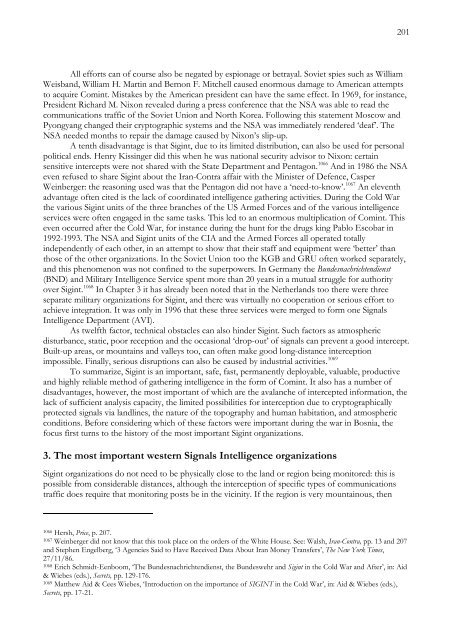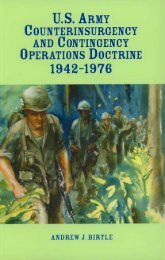C. Wiebes - Intelligence en de oorlog in Bosnië 1992-1995. De rol van de inlichtingen- en veiligheidsdiensten - Engels
C. Wiebes - Intelligence en de oorlog in Bosnië 1992-1995. De rol van de inlichtingen- en veiligheidsdiensten - Engels
C. Wiebes - Intelligence en de oorlog in Bosnië 1992-1995. De rol van de inlichtingen- en veiligheidsdiensten - Engels
- No tags were found...
You also want an ePaper? Increase the reach of your titles
YUMPU automatically turns print PDFs into web optimized ePapers that Google loves.
201All efforts can of course also be negated by espionage or betrayal. Soviet spies such as WilliamWeisband, William H. Mart<strong>in</strong> and Bernon F. Mitchell caused <strong>en</strong>ormous damage to American attemptsto acquire Com<strong>in</strong>t. Mistakes by the American presid<strong>en</strong>t can have the same effect. In 1969, for <strong>in</strong>stance,Presid<strong>en</strong>t Richard M. Nixon revealed dur<strong>in</strong>g a press confer<strong>en</strong>ce that the NSA was able to read thecommunications traffic of the Soviet Union and North Korea. Follow<strong>in</strong>g this statem<strong>en</strong>t Moscow andPyongyang changed their cryptographic systems and the NSA was immediately r<strong>en</strong><strong>de</strong>red ‘<strong>de</strong>af’. TheNSA nee<strong>de</strong>d months to repair the damage caused by Nixon’s slip-up.A t<strong>en</strong>th disad<strong>van</strong>tage is that Sig<strong>in</strong>t, due to its limited distribution, can also be used for personalpolitical <strong>en</strong>ds. H<strong>en</strong>ry Kiss<strong>in</strong>ger did this wh<strong>en</strong> he was national security advisor to Nixon: certa<strong>in</strong>s<strong>en</strong>sitive <strong>in</strong>tercepts were not shared with the State <strong>De</strong>partm<strong>en</strong>t and P<strong>en</strong>tagon. 1066 And <strong>in</strong> 1986 the NSAev<strong>en</strong> refused to share Sig<strong>in</strong>t about the Iran-Contra affair with the M<strong>in</strong>ister of <strong>De</strong>f<strong>en</strong>ce, CasperWe<strong>in</strong>berger: the reason<strong>in</strong>g used was that the P<strong>en</strong>tagon did not have a ‘need-to-know’. 1067 An elev<strong>en</strong>thad<strong>van</strong>tage oft<strong>en</strong> cited is the lack of coord<strong>in</strong>ated <strong>in</strong>tellig<strong>en</strong>ce gather<strong>in</strong>g activities. Dur<strong>in</strong>g the Cold Warthe various Sig<strong>in</strong>t units of the three branches of the US Armed Forces and of the various <strong>in</strong>tellig<strong>en</strong>ceservices were oft<strong>en</strong> <strong>en</strong>gaged <strong>in</strong> the same tasks. This led to an <strong>en</strong>ormous multiplication of Com<strong>in</strong>t. Thisev<strong>en</strong> occurred after the Cold War, for <strong>in</strong>stance dur<strong>in</strong>g the hunt for the drugs k<strong>in</strong>g Pablo Escobar <strong>in</strong><strong>1992</strong>-1993. The NSA and Sig<strong>in</strong>t units of the CIA and the Armed Forces all operated totally<strong>in</strong><strong>de</strong>p<strong>en</strong>d<strong>en</strong>tly of each other, <strong>in</strong> an attempt to show that their staff and equipm<strong>en</strong>t were ‘better’ thanthose of the other organizations. In the Soviet Union too the KGB and GRU oft<strong>en</strong> worked separately,and this ph<strong>en</strong>om<strong>en</strong>on was not conf<strong>in</strong>ed to the superpowers. In Germany the Bun<strong>de</strong>snachricht<strong>en</strong>di<strong>en</strong>st(BND) and Military <strong>Intellig<strong>en</strong>ce</strong> Service sp<strong>en</strong>t more than 20 years <strong>in</strong> a mutual struggle for authorityover Sig<strong>in</strong>t. 1068 In Chapter 3 it has already be<strong>en</strong> noted that <strong>in</strong> the Netherlands too there were threeseparate military organizations for Sig<strong>in</strong>t, and there was virtually no cooperation or serious effort toachieve <strong>in</strong>tegration. It was only <strong>in</strong> 1996 that these three services were merged to form one Signals<strong>Intellig<strong>en</strong>ce</strong> <strong>De</strong>partm<strong>en</strong>t (AVI).As twelfth factor, technical obstacles can also h<strong>in</strong><strong>de</strong>r Sig<strong>in</strong>t. Such factors as atmosphericdisturbance, static, poor reception and the occasional ‘drop-out’ of signals can prev<strong>en</strong>t a good <strong>in</strong>tercept.Built-up areas, or mounta<strong>in</strong>s and valleys too, can oft<strong>en</strong> make good long-distance <strong>in</strong>terception1069impossible. F<strong>in</strong>ally, serious disruptions can also be caused by <strong>in</strong>dustrial activities.To summarize, Sig<strong>in</strong>t is an important, safe, fast, perman<strong>en</strong>tly <strong>de</strong>ployable, valuable, productiveand highly reliable method of gather<strong>in</strong>g <strong>in</strong>tellig<strong>en</strong>ce <strong>in</strong> the form of Com<strong>in</strong>t. It also has a number ofdisad<strong>van</strong>tages, however, the most important of which are the avalanche of <strong>in</strong>tercepted <strong>in</strong>formation, thelack of suffici<strong>en</strong>t analysis capacity, the limited possibilities for <strong>in</strong>terception due to cryptographicallyprotected signals via landl<strong>in</strong>es, the nature of the topography and human habitation, and atmosphericconditions. Before consi<strong>de</strong>r<strong>in</strong>g which of these factors were important dur<strong>in</strong>g the war <strong>in</strong> Bosnia, thefocus first turns to the history of the most important Sig<strong>in</strong>t organizations.3. The most important western Signals <strong>Intellig<strong>en</strong>ce</strong> organizationsSig<strong>in</strong>t organizations do not need to be physically close to the land or region be<strong>in</strong>g monitored: this ispossible from consi<strong>de</strong>rable distances, although the <strong>in</strong>terception of specific types of communicationstraffic does require that monitor<strong>in</strong>g posts be <strong>in</strong> the vic<strong>in</strong>ity. If the region is very mounta<strong>in</strong>ous, th<strong>en</strong>1066 Hersh, Price, p. 207.1067 We<strong>in</strong>berger did not know that this took place on the or<strong>de</strong>rs of the White House. See: Walsh, Iran-Contra, pp. 13 and 207and Steph<strong>en</strong> Engelberg, ‘3 Ag<strong>en</strong>cies Said to Have Received Data About Iran Money Transfers’, The New York Times,27/11/86.1068 Erich Schmidt-E<strong>en</strong>boom, ‘The Bun<strong>de</strong>snachricht<strong>en</strong>di<strong>en</strong>st, the Bun<strong>de</strong>swehr and Sig<strong>in</strong>t <strong>in</strong> the Cold War and After’, <strong>in</strong>: Aid& <strong>Wiebes</strong> (eds.), Secrets, pp. 129-176.1069 Matthew Aid & Cees <strong>Wiebes</strong>, ‘Introduction on the importance of SIGINT <strong>in</strong> the Cold War’, <strong>in</strong>: Aid & <strong>Wiebes</strong> (eds.),Secrets, pp. 17-21.





